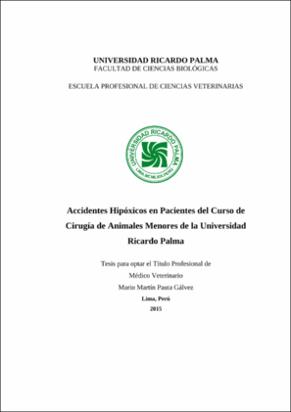| dc.contributor.author | Pauta Gálvez, Mario Martin | |
| dc.date.accessioned | 2016-08-10T20:27:49Z | |
| dc.date.available | 2016-08-10T20:27:49Z | |
| dc.date.issued | 2015 | |
| dc.identifier.uri | https://hdl.handle.net/20.500.14138/700 | |
| dc.description.abstract | Una de las principales complicaciones durante la anestesia de un proceso quirúrgico es el monitoreo de los problemas de oxigenación del paciente; la falta de oxigenación desencadena un estado de hipoventilación que consecuentemente produce un estado de hipoxemia, lo cual conllevará a un severo deterioro en la salud del paciente y, en el peor de los casos, a la muerte del mismo. El objetivo de este estudio fue determinar el porcentaje de accidentes hipóxicos en pacientes del curso de Cirugía de Animales Menores de la Universidad Ricardo Palma en la ciudad de Lima. Se evaluaron 45 fichas clínicas de registro anestésico entre Agosto del 2012 a Julio del 2014; con los protocolos de Xilacina - Ketamina (Protocolo 1); Xilacina - Ketoprofeno - Ketamina (Protocolo 2) y Xilacina - Tramadol - Ketamina (Protocolo 3). Las fichas de record anestésico se analizaron mediante los programas SPSS y Microsoft Excel. Los resultados promedio indicaron que del total del tiempo de cirugía en cada paciente, el 55% de dicho tiempo el paciente se encontraba en hipoxemia, con un valor de saturación de oxígeno de 92 ± 4.4. Los resultados por protocolo anestésico mostraron un mayor porcentaje de hipoxemia con el Protocolo 3. Los resultados por American Society of Anesthesiologists (ASA) presento un mayor porcentaje de hipoxemia en los ASA 1. Por otro lado se mostraron un mayor porcentaje de hipoxemia en la especie felina. Asimismo se demostró un mayor porcentaje de hipoxemia en ovariohisterectomías. Se comprobó la existencia de estados hipoxémicos en los procedimientos quirúrgicos de la Sala de Cirugía de Animales Menores recomendándose realizar un monitoreo más exhaustivo de constantes vitales en los diferentes procedimientos quirúrgicos y clasificaciones ASA, empleando las diferentes fichas de monitoreo para cada especie. One of the main complications of anesthesia during a surgical procedure, it´s the monitoring of patient oxygenation problems, the lack of oxygen trigger a state of hypoventilation which consequently produces a state of hypoxia, which it would give rise to a severe deterioration in the health of the patient and in the worst cases, death of it self. The aim of this study was to determine the percentage of hypoxic injury in patients during surgery of small animals in the Ricardo Palma´s University in Lima. 45 anesthesic records registered from August 2012 to July 2014; with the protocols of Xylazine – Ketamine (Protocol 1); Xylazine – Ketoprofen – Ketamine (Protocol 2) and Xylazine – Tramadol – Ketamine (Protocol 3) were analyzed using SPSS and Microsoft excel. The average results indicated that the total operation time for each patient, 55% of the time the patient was in hypoxemia with oxygen saturation value 92 +- 4.4. the results for anesthesic protocol demonstrated higher percentage of hypoxemia with Protocol 3. The results for ASA demonstrated a higher percentage of hypoxemia in the ASA 1. On the other hand a higher percentage of hypoxemia were shown in the feline species. A higher percentage of hypoxemia in ovariohysterectomiy is also demonstrated. The existence of hypoxemic states in surgical procedures for the surgery of small animals recommending more comprehensive monitoring of vital signs in different surgical procedures and ASA classifications using different monitoring records for each species registered | es |
| dc.description.uri | Tesis | es |
| dc.format | application/pdf | |
| dc.language.iso | spa | es |
| dc.publisher | Universidad Ricardo Palma | es |
| dc.rights | info:eu-repo/semantics/openAccess | es |
| dc.rights.uri | https://creativecommons.org/licenses/by-nc/4.0/ | |
| dc.source | Universidad Ricardo Palma | es |
| dc.source | Repositorio institucional - URP | es |
| dc.subject | Accidentes anestésicos | es |
| dc.subject | Hipoxemia | es |
| dc.subject | Caninos y felinos | es |
| dc.subject | Anesthetic accidents | es |
| dc.subject | Hypoxemia | es |
| dc.subject | Canine and feline | es |
| dc.title | Accidentes Hipóxicos en Pacientes del Curso de Cirugía de Animales Menores de la Universidad Ricardo Palma | es |
| dc.type | info:eu-repo/semantics/bachelorThesis | es |
| thesis.degree.discipline | Medicina Veterinaria | es |
| thesis.degree.grantor | Universidad Ricardo Palma. Facultad de Ciencias Biológicas | es |
| thesis.degree.level | Título Profesional | es |
| thesis.degree.name | Médico Veterinario | es |
| dc.publisher.country | PE | |


